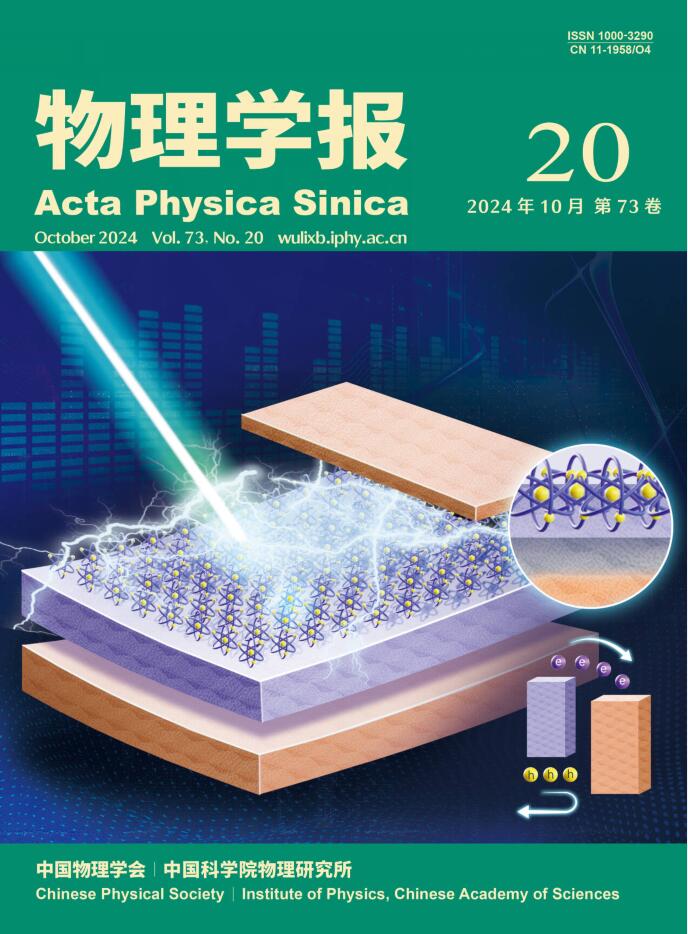稀土掺杂Gd2Te4O11碲酸盐荧光粉的合成及其发光性能
IF 0.8
4区 物理与天体物理
Q3 PHYSICS, MULTIDISCIPLINARY
引用次数: 0
摘要
采用水热法制备了一系列稀土Dy3+、Tb3+、Eu3+单掺杂的GTO (Gd2Te4O11)碲酸盐本质极性荧光粉。表征了荧光粉的相结构、形貌和热稳定性。并对其发光性能进行了详细测试。结果表明,这些荧光粉均结晶为单相短棒状碲二adolinium。轴向最大尺寸达到微米级。该荧光粉具有良好的热稳定性。对于GTO:Dy3+,紫外激发下的荧光发射主要位于黄绿色区域。激发和发射最强对应的最佳掺杂浓度为2.5%,CIE色坐标为(0.39,0.43)。荧光衰减曲线显示,随着Dy3+掺杂浓度的增加,GTO:Dy3+在4F9/2能级上的寿命逐渐降低,这可能与Dy3+离子之间的交叉弛豫(CR)有关。对于GTO:Eu3+,紫外激发下的荧光发射主要位于红色和橙红色区域。发射强度随Eu3+掺杂浓度的增加而增强。当掺杂浓度为10%时,CIE色坐标为(0.62,0.38),位于橙色-红色区域,颜色纯度较高。Eu3+在5D0能级上的荧光寿命几乎不受Eu3+掺杂浓度变化的影响。对于GTO:Tb3+,随着Tb3+浓度的增加,紫外激发下的荧光发射由蓝紫色区变为黄绿色区,这可归因于Tb3+离子间CR的影响。荧光衰减行为表明,5D4激发态上的Tb3+离子可能发生能量转移和重吸收,偏离了单指数模型的荧光衰减。当Tb3+浓度为0.5%时,样品发出白光,CIE色坐标为(0.33,0.35),显色指数为86。温度依赖性发射光谱的测量表明,上述荧光粉具有良好的发光热稳定性。结果表明,GTO:Eu3+的内量子效率优于GTO:Dy3+和GTO:Tb3+的内量子效率。所有这些荧光粉在发光性能上仍有很大的改进空间。这些荧光粉有潜力用于紫外线激发的白光LED。本文章由计算机程序翻译,如有差异,请以英文原文为准。
Synthesis and luminescent properties of rare earths doped Gd2Te4O11 tellurite phosphors
A series of rare earth Dy3+, Tb3+, Eu3+ singly doped Gd2Te4O11 (GTO) tellurite phosphors with intrinsic polarity were prepared by hydrothermal method. The phase structure, morphology and thermal stability of the phosphors were characterized. Their luminescence properties were tested in detail. The results show all those phosphors were crystalized into single phase of digadolinium tellurite with short rod-like shape. The maximum size achieved microns in axial direction. The phosphors have good thermal stability. For the GTO:Dy3+, the fluorescence emission under UV excitation is mainly located in the yellow-green region. The optimal doping concentration corresponding to the strongest excitation and emission is 2.5%, and the CIE color coordinates are (0.39, 0.43). The fluorescence decay curves show that the lifetime of the GTO:Dy3+ on 4F9/2 energy level decreases gradually with increasing doping concentration of Dy3+, which may be related to the cross relaxation (CR) between Dy3+ ions. For the GTO:Eu3+, the fluorescence emission under UV excitation is mainly located in the red and orange-red regions. The emission intensity was enhanced with increasing doping concentration of Eu3+. When the doping concentration is 10%, the CIE color coordinates are (0.62, 0.38), which located in the orange-red region with high color purity. The fluorescence lifetime of Eu3+ on 5D0 energy level is hardly affected by the change of Eu3+ doping concentration. For the GTO:Tb3+, with increasing the Tb3+ concentration, the fluorescence emission under UV excitation changes from blue-violet region to yellow-green region, which can be ascribed to the influence of CR between Tb3+ ions. The fluorescence decay behavior revealed that the Tb3+ ions on 5D4 excited state may undergo energy transfer and reabsorption, which deviated fluorescence decay from the single exponential model. When the concentration of Tb3+ is 0.5%, the sample exhibits white light emission, having the CIE color coordinates of (0.33, 0.35) and color rendering index of 86. The measurements of temperature-dependent emission spectra show that the above-mentioned phosphors have good luminescent thermal stability. The internal quantum efficiencies (IQE) of those three types of phosphors were tested, and the IQE of GTO:Eu3+ are better than those of GTO:Dy3+ and GTO:Tb3+. All those phosphors still have much room for improvement in the luminescent performance. These phosphors have potential for the use of UV-excited white LED.
求助全文
通过发布文献求助,成功后即可免费获取论文全文。
去求助
来源期刊

物理学报
物理-物理:综合
CiteScore
1.70
自引率
30.00%
发文量
31245
审稿时长
1.9 months
期刊介绍:
Acta Physica Sinica (Acta Phys. Sin.) is supervised by Chinese Academy of Sciences and sponsored by Chinese Physical Society and Institute of Physics, Chinese Academy of Sciences. Published by Chinese Physical Society and launched in 1933, it is a semimonthly journal with about 40 articles per issue.
It publishes original and top quality research papers, rapid communications and reviews in all branches of physics in Chinese. Acta Phys. Sin. enjoys high reputation among Chinese physics journals and plays a key role in bridging China and rest of the world in physics research. Specific areas of interest include: Condensed matter and materials physics; Atomic, molecular, and optical physics; Statistical, nonlinear, and soft matter physics; Plasma physics; Interdisciplinary physics.
 求助内容:
求助内容: 应助结果提醒方式:
应助结果提醒方式:


